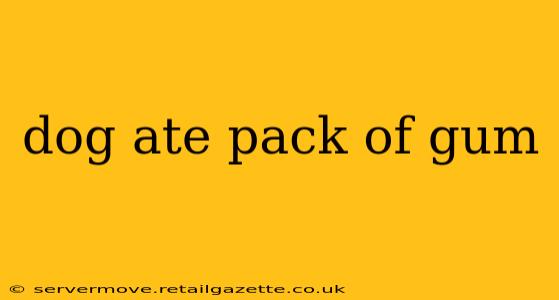Finding an empty pack of gum where your dog was moments before can be a terrifying experience. Xylitol, an artificial sweetener found in many sugar-free gums, is incredibly toxic to dogs. Even small amounts can lead to a life-threatening drop in blood sugar (hypoglycemia) and liver failure. This article will guide you through the immediate steps to take and answer common questions about this emergency.
What are the signs of xylitol poisoning in dogs?
This is often the first and most urgent question pet owners have. Symptoms can appear within 30 minutes to 12 hours after ingestion and vary in severity depending on the amount of xylitol consumed and the size of the dog. Watch for these signs:
- Weakness: Your dog may seem unusually tired or lethargic.
- Tremors: Noticeable shaking or trembling.
- Vomiting: This can be a common symptom.
- Loss of coordination: Difficulty walking or standing.
- Seizures: In severe cases, seizures can occur.
- Low blood sugar (hypoglycemia): This can lead to collapse and unconsciousness.
- Liver failure: This is a more delayed consequence and can be life-threatening.
If you suspect your dog has ingested xylitol, even a small amount, do not wait to see if symptoms develop. Act immediately.
My dog just ate gum. How much xylitol is dangerous?
The amount of xylitol that's toxic varies widely depending on the dog's size and the type of gum. There's no safe level. Even a tiny amount of xylitol in sugar-free gum can cause serious problems. Larger dogs may tolerate slightly more than smaller ones before exhibiting symptoms. The best course of action is to always seek immediate veterinary care.
What should I do if my dog ate gum containing xylitol?
Time is crucial. Here's what to do:
- Contact your veterinarian or an animal poison control center immediately. They will provide specific advice based on your dog's size, the amount of gum ingested, and the type of gum. (Note: You may be charged a consultation fee by poison control centers).
- Don't induce vomiting at home without professional guidance. While it might seem like a good idea, improper methods can be more harmful than helpful. Your vet or poison control will advise on the best course of action.
- Gather information: Have the gum packaging ready so you can accurately describe the type and amount ingested to your vet.
- Take your dog to the vet or emergency animal hospital as soon as possible. They may administer activated charcoal or other treatments to help your dog.
What if the gum doesn't contain xylitol?
While xylitol is the primary concern, other ingredients in gum can still cause upset stomachs. Watch for symptoms such as vomiting, diarrhea, or lethargy. If these are severe or persistent, consult your veterinarian.
How can I prevent this from happening again?
Prevention is key. Store gum and other potentially harmful products out of reach of your dog. Keep all medications and sweets securely locked away. Train your dog to leave things alone, using positive reinforcement methods.
Disclaimer: This article is for informational purposes only and does not constitute veterinary advice. Always consult a veterinarian or animal poison control center if your dog ingests anything potentially harmful. The information provided here should not replace professional medical advice.
